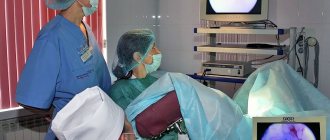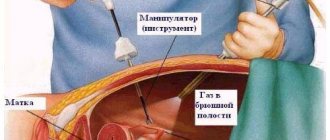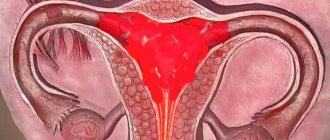A benign neoplasm called a cyst may appear in the ovarian tissue. Its dimensions can reach 15 cm in diameter. The formation is attached with the help of a stalk and grows at the expense of the host organ, like a parasite. Such a tumor does not pose a direct threat to health. Still, there are risks, especially if the tumor begins to grow at a rapid pace.
Often, delaying a visit to a specialist leads to the fact that a woman is already indicated for laparotomy of an ovarian cyst. What it is? We'll tell you below.
When is laparotomy prescribed?
If cystic formations are detected on the ovaries, treatment tactics depend on their size, the woman’s well-being and ultrasound findings. Small neoplasms filled with liquid, up to 2-3 cm in size, require observation. But if the cyst exceeds 10 cm in size, there is a high probability of its degeneration into a malignant tumor. In this case, surgical removal is prescribed.
There are two such methods:
- laparotomy,
- abdominal surgery.
Open abdominal surgery is the excision of a cystic formation through an incision at the pubic bone in the lower abdomen. In this case, the doctor clearly sees the affected organ and adjacent tissues and can visually assess their condition, identify a cancerous tumor or metastases to other organs and lymph nodes.
Laparotomy is a method of removing tumors on the ovary through small punctures in the peritoneum. Through them, the doctor introduces special instruments for performing manipulations. This is a camera, a laparoscope. Laparotomy is indicated for small, uncomplicated cysts.
How is laparotomy performed?
This operation is performed only under general anesthesia. Before laparotomy, a woman undergoes a complete cleansing of the intestines using an enema, and just before the operation she should refuse to eat or drink liquids.
At the beginning of the operation, after pre-treatment of the skin with antiseptic agents, a horizontal incision is made in the lower part of the abdominal cavity. The surgeon then carefully removes the cysts using an excision technique.
At the same time, all neighboring organs must be examined so as not to miss possible metastases or their formation. Depending on what is discovered during surgery, one or both ovaries may be removed at once.
Before laparotomy, a woman undergoes a complete cleansing of the intestines using an enema.
Severe bleeding is stopped by ligation of blood vessels or by cauterization. The seams are formed on the cut very carefully, since the tissue of the appendage is incredibly thin. Removed ovarian cysts are sent for examination. This allows you to make sure that the neoplasm is not malignant.
Indications for laparotomy
Any surgical intervention involves certain risks to life and health. Therefore, abdominal surgery is resorted to in extreme cases, trying to cure a disease or pathology conservatively. Cavitary removal of an ovarian cyst is recommended in cases where the neoplasm is large and there is confirmation or suspicion of cancer. An indication is also the atypical location of the cyst or other pathologies of the female reproductive system.
Emergency abdominal surgery is performed in the following cases:
- suppuration of cystic formation,
- ovarian torsion,
- ectopic pregnancy,
- rupture of the cyst and ovarian tissue.
Laparotomy is indicated if there is a simple uncomplicated cyst up to 6-7 cm in size or multiple small cysts - polycystic. The doctor should have no doubts about the benign quality of the formation. Both operations are performed under general anesthesia.
Diagnostic features
It is necessary to undergo diagnostics to make a correct diagnosis. It happens that a woman has concomitant gynecological diseases, which can act as an obstacle to the operation. In such a situation, it is first necessary to cure the disease, and then undergo diagnostics again and begin treatment of the cyst.
You can identify a cyst using:
- gynecological examination, taking into account complaints and symptoms;
- ultrasound examination of the reproductive organs of the pelvis;
- using a puncture (puncture in the back wall of the vagina);
- CT;
- mapping.
Additionally, the doctor may prescribe blood and urine tests, and will also recommend pregnancy testing. If the test turns out to be negative, then this is confirmation that a cyst has formed and not an ectopic pregnancy.
Contraindications
Before abdominal surgery and laparotomy, the woman is examined to identify direct or indirect contraindications to their implementation. Surgical interventions are strictly prohibited for:
- stroke, heart attack, other serious pathologies of the cardiovascular system,
- blood diseases associated with blood clotting disorders,
- any chronic diseases in the acute stage,
- decompensated diabetes mellitus.
In the presence of acute chronic or infectious conditions, abdominal surgery is postponed until recovery or stabilization of the condition.
Laparotomy of ovarian cyst during pregnancy
During the period of bearing a child, in special cases, doctors raise the question of removing the cyst by laparotomy. This is done in case of a threat of miscarriage, rapid growth of the cyst, its suppuration or rupture. In other cases, laparoscopy is performed.
Laparotomy is usually performed under general anesthesia, but sometimes an epidural is used, similar to a caesarean section. Any operation is a threat to the fetus, so it is performed only in cases where the expected benefit outweighs the potential risk.
Technique of laparotomy
The cyst is surgically removed through a deep incision in the abdomen. The doctor can make both a longitudinal and transverse incision 10-15 cm long. First, the skin is treated with an antiseptic, after which the doctor excises the skin, subcutaneous fat and peritoneum, stretches the edges of the hole and begins to study the pathology.
The following options for the outcome of the operation are possible:
- cyst removed
- a cyst with part of the ovarian tissue was removed,
- cyst and ovary removed,
- A cyst with an ovary, a fallopian tube, and a lymph node was identified.
It all depends on the type of cystic formation and its benign quality. If the doctor suspects that the tumor is malignant, he removes it along with adjacent tissues and lymph nodes. After removal, the specialist stitches the incision and applies a bandage to the seam. The patient is in intensive care for the next two days.
How long does surgery to remove an ovarian cyst take?
For ovarian cysts, abdominal surgery lasts 2-4 hours. First of all, the time of surgical intervention depends on the severity of the tumor. Uncomplicated cysts with liquid contents are removed quickly without damaging the ovarian tissue. In other cases, the doctor grabs ovarian tissue. On average, such manipulations take no more than 2 hours. If a suspicious tumor is detected, metastases to other organs and lymph nodes are visible, the operation is delayed up to 4 hours or more. Laparotomy lasts 40-60 minutes.
How to treat tartar at home: effective methods
Discussion: 12 comments
- lastl7774:
08/12/2016 at 02:20Who did labiaplasty? What was the result? Has the sensitivity decreased? And how much did the procedure cost? Maybe there are doctors on the forum, tell me. Is it possible to fix an old injury?
- vaduml12:
08/12/2016 at 02:21
Well, I did. not because of injury, but simply because the MPG were too large if delayed. then four centimeters, even a little more (((Because of this, I was terribly complex, and somehow the guy didn’t really like it, although he didn’t say anything. I was pleased with the result, regarding sensitivity - I would say even the opposite, or maybe It seems to me so, because the complexes have gone away)) The first days after the operation are terrible, of course, but you need to get ready for it, and it’s really much more comfortable. Now I can wear any underwear, nothing rubs, doesn’t pinch, etc. By the way, with I broke up with my boyfriend, now I’m married))) And my husband says that it was in vain to operate, he likes them very much)))))))))))))))) So if only because of the appearance, then think before do it, and if it’s really uncomfortable, then feel free to do it - don’t be afraid.
- pomano125:
08/12/2016 at 02:23
I did it there too, with doctor Ekaterina Nikolaevna Zhumanova!!!!! What kind of person is this!!! Her friends were probably lucky: I have never met a more balanced, confident and professional person!! What I like: he doesn’t try, like most people today, to rip off more money from you, but actually advises different options to make it cheaper, or tells you to wait, don’t rush!! But I decided to have labiaplasty, especially since there was a promotion, and everything cost 15,000 rubles!! It seems to me that we won’t be able to get it cheaper anywhere in Moscow!
- lastl7774:
09/08/2016 at 21:07
who removed polyps in the uterus? How much does surgery cost in Moscow now?
- aklo:
09/08/2016 at 21:08
It depends where and how you delete it. In a private clinic, of course, it’s more expensive
- Polina:
09/08/2016 at 21:09
And I will never go to a private owner again! They almost killed me... there is no responsibility there! In the residential complex, doctors are at least afraid of someone! They treated me so that the cyst almost burst and was taken away by ambulance with wild pain! An urgent operation was performed, the doctor later said that it was a good thing that they might or might not have made it in time...
- Vika:
09/08/2016 at 21:11
. Polyps are burned with a laser, the most reliable method, but a bit expensive.
- ellga:
09/08/2016 at 21:16
I wouldn't say. or maybe I was just lucky) The polyp was removed at the Center of the Ministry of Health, second gynecological department. The service is truly European (I lived in Switzerland for three years, so I know what I’m talking about!), I would say the prices are below the Moscow average. Everything is on the level, and it’s not only about modern equipment, and not even about it at all, but about the attitude of the staff towards patients! A very experienced doctor, Ekaterina Nikolaevna Zhumanova, she advised, she also performed the operation. I was surprised that after the operation I personally came into the room several times and inquired about my well-being!
- Christmas tree:
10/19/2016 at 22:34
Good evening. Yesterday I saw the doctor - an endometrial polyp. Anyone who had a similar problem, tell me what to do next!!! I’m in despair, I’ve never been sick except for a runny nose and the flu, and here it is!
- Denya:
10/19/2016 at 22:55
Author, how I understand you! Two years ago I started having terrible abdominal pain, like contractions. There was also bloody discharge at the end of menstruation, liquid was released from the nipples, as in the first days after childbirth. The child is four years old, she nursed until she was five months old, that is, there could no longer be any milk!! I told it to my friends - they consoled me: one of them says she knows a gynecologist and says that many people come to the doctor with similar symptoms, and he immediately sends her to oncology!!! Imagine my reaction! And on the Internet I found such diagnoses, even a brain tumor, so I didn’t want to go to the doctor at all. Thanks to my husband, he forced me, almost forcibly took me to the doctor, his classmate works in the clinic, he recommended the doctor to Ekaterina Nikolaevna Zhumanova! It was real luck; I have never met more responsive doctors! Calming an alarmist like me is a real talent!!))))) She performed a polyectomy. A very attentive person, gives clear and understandable instructions, explains what is needed for what! And in general, the entire staff is responsive - you feel like a patient who they want to help, and not a bag for pumping out money)) Now I see him once every six months, and after the operation I took a course of hormones, and everything got better with my breasts...
- Zhanna:
10/19/2016 at 22:59
My mother was treated by Zhumanova, and she had very pleasant impressions.
- Christmas tree:
10/19/2016 at 23:01
): Thank you, I’ve calmed down a bit.. How much does laser removal cost approximately?
How many days of sick leave after ovarian laparotomy?
Each individual case is individual. With a simple operation and a quick recovery of the patient, the sick leave is closed after 2 weeks. This is the average period of time that is given for the body to recover.
Of course, it takes about 3 months to rehabilitate and fully restore a woman’s health. But a person is actually able to begin performing professional duties after the operation on the 15th day.
Postoperative period and rehabilitation
In the first 2 days after abdominal surgery, the woman is in the intensive care unit. She is prescribed bed rest, a minimum of physical activity, sleep and light nutrition. On average, the postoperative period lasts 1-2 weeks. At this time, the medical staff processes the suture, and the woman receives drug treatment to avoid the development of complications.
The patient may feel unpleasant pain in the suture area, hoarseness and dry throat, chills, and mild malaise. These symptoms pass quickly and are echoes of anesthesia.
Over time, it is important to gradually apply light loads to the abdominal area in order to normalize blood flow in the peritoneum and accelerate tissue regeneration and fusion of the suture edges. The speed of recovery after abdominal surgery to remove an ovarian cyst depends on the patient’s health level and compliance with the doctor’s recommendations. As for restoring the functioning of a woman’s reproductive system, everything is purely individual.
Important! Menstruation may occur 1-2 days or a month after abdominal surgery.
On average, complete recovery in the absence of complications will take 10-12 weeks. It is during this period that a woman is often prescribed hormonal contraceptives in order to normalize hormonal levels, the cycle and protect against pregnancy. Doctors recommend using contraception for the first 3 months and planning a baby after the recovery period.
Preparation for laparotomy
If a woman decides to undergo surgery, the doctor prescribes her to undergo a set of certain procedures. To successfully perform a laparotomy, you must strictly follow the doctor's instructions.
- First you need to pass all the necessary tests - blood, urine.
- Rule out the presence of infectious diseases.
- The day before the operation, it is forbidden to eat heavy food; only liquid foods are allowed.
- 8-10 hours before surgery, the patient is allowed to drink only water.
- Before the laparotomy itself, it is necessary to cleanse the intestines using an enema.
Following all instructions makes the surgeon’s work easier, which will allow him to perform the operation faster and with better quality.
On average, the operation takes from 30 minutes to 1.5 hours. The time is influenced by various factors, such as the experience of the surgeon, the degree of the disease. The time may increase if any complications arise.
Possible complications
Complications after abdominal surgery to remove an ovarian cyst and laparotomy are rare. They are often associated with non-compliance with bed rest and doctor's recommendations. In this case it is possible:
- suture dehiscence or suppuration,
- internal bleeding,
- thromboembolism.
If the patient moves too actively and incorrectly calculates the load, a postoperative hernia may develop.
Abdominal surgery to remove an ovarian cyst is a serious surgical procedure that requires careful preparation of the patient. If the outcome is successful and the formation is benign, the body recovers after 2-3 months, and the woman can plan a pregnancy.
How is the recovery going?
The woman should remain under medical supervision for 4-5 days. In the first days of the postoperative period, pain is possible in the area of the operation, and to reduce it, the doctor prescribes painkillers. To avoid constipation, a strict diet is recommended for the first three days. The sutures are removed on the 7-8th day after surgery.
Recommendations during the recovery period are as follows:
- do not let the stitches get wet until the doctor gives permission;
- Do not take a bath for a month, but bathe exclusively in the shower;
- maintain a balanced diet;
- do not lift weights and avoid heavy physical activity;
- Avoid sexual intercourse for at least a month.
It is very important to follow all the doctor’s instructions and take the medications prescribed by him exactly.
When do periods return?
Discharge for a week after the procedure is normal. At first they resemble menstruation, and after a couple of days they transform into spotting, then, for a maximum of a couple more weeks, the discharge may be mucous or yellowish, there should be no pain or unpleasant odor.
Important! Green or brown discharge, accompanied by pain and an unpleasant odor, is a very good reason to see a doctor.
With a successful intervention, menstruation most often comes on time, but sometimes there may be a slight delay in the first cycle. If the operation was accompanied by complications, menstruation may be absent for several cycles in a row.
If the delay lasts more than 3 months, the following reasons are possible:
- hormonal disruptions;
- sudden weight loss;
- onset of menopause – surgery can trigger premature menopause;
- the presence of complications associated with medical negligence.
If the delay in menstruation is caused by stress or sudden weight loss, then as soon as the patient regains weight and takes a course of sedatives, the cycle should normalize.
If a hormonal imbalance occurs, you will need to take medications to normalize it. This can take up to six months.
Expert opinion
Anna Alekseenko
Obstetrician-gynecologist
5 years experience
If the delays are associated with infectious processes, the doctor will prescribe antibiotics and suppositories; as soon as the infection is stopped, the menstrual cycle will improve. If, as a result of the intervention, adhesions have formed on the tubes or the uterus has been damaged, the restoration of the cyclicity of menstruation may take several years.
Reviews
Angelina, 29 years old, Stavropol After laparotomy, the ovarian cyst took a long time to recover, almost 4 months. All this time, the stitch hurt, there was weakness, and there was a tugging in the lower abdomen. After being discharged from the hospital on the 7th day, I went to the clinic for procedures and injections for another 2 weeks. In general, it was difficult to survive this operation. Ksenia, 32 years old, Moscow The abdominal surgery was unplanned, as she was admitted to the hospital with an ectopic pregnancy. They did everything quickly and well, after 5 days I was already at home, but walking and bending was painful and the constant weakness did not leave for another 2 weeks. My period started after 10 days.











